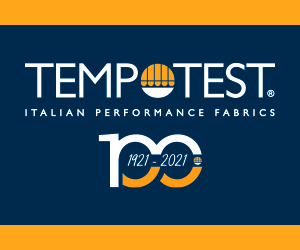Sophis Network Printing Technology Aims to End Dark Days of 'Sneakernet'
April 14, 2000
Frankfurt, Germany - Karl Noonan, technical director of Sophis Systems and of the Sophis Group, has worked in textile printing for about 20 years, but one thing still mystifies him about the business.
''Computers have been networked for years but most computerized looms are not,'' Noonan said. ''The technology exists now so that we can stop running around with floppies. Yet what we have right now is a 'sneakernet.' You run from one loom to the other with your sneakers on. This is one of the greatest mysteries to me.''
As a result, Sophis, which Noonan describes as a ''solution provider,'' has taken steps to solve the mystery. Namely, it demonstrated at Heimtextil a new model for direct on-line weaving. Noonan said the system offers flexibility and efficiency.
''With this new software, you can have one design file that automatically delivers information to any of the machines,'' he said. ''With fewer copies of the design - one - there is less chance for error, waste of material, waste of time.
''In the network, you can have at one site a mix of old and new looms. You can have machines from different suppliers. You are not locked into any one jacquard supplier. If you have to change, you have the freedom to.''
Noonan said that the network technology functions two ways: it delivers designs, either to electronic jacquards or mechanical looms; and it also monitors the various steps in the weaving operations.
''You can mix jacquard and dobby with mechanical and electronic heads,'' he said. He said that loom planning is also possible. ''You can solve the most complex layouts of a firm.''
NETWORKED PRINTING The most modern printers are entirely digital. ''We are not going to have any Sophis printer who is not networked,'' said Noonan. He said that all the Sophis printers are automatically networked when they are installed so that no customer has to perform the 'sneakernet' with floppies, CDs or optical disks.
Noonan said that already, several Sophis customers are networked between sites. For example, in Randa International the designs are prepared in the middle of Como, Italy and sent to their warehouse to be printed. They are just waiting for the day when New York is added to their network.
''The digital printing is progressing very well,'' said Noonan. ''We now have sites who are really into 'mini' production. The biggest is already producing 3,000 meters per month and another is producing 1,500. The added value that they get makes them very profitable even at these small production rates.''
The variety of products which they are printing digitally is ''incredible,'' Noonan said. It ranges from banners to blankets, from silk to polyester, from acids to pigments. ''We have not printed everything yet but almost everything,'' Noonan said. ''The present customers are in a learning phase, they are transforming their companies into the future where 'short runs' and 'just in time' are realities and not just words.''
The new 200 meter an hour digital printer will be shown at Druppa in May and then the printers will have a production machine. ''The printers working digital today will have the advantage,'' said Noonan. ''The difference between traditional printing and the digital printing is one of the culture of the company. I can roll in a digital printer in one day, but it takes months to swap the mentality of the company.''
''Computers have been networked for years but most computerized looms are not,'' Noonan said. ''The technology exists now so that we can stop running around with floppies. Yet what we have right now is a 'sneakernet.' You run from one loom to the other with your sneakers on. This is one of the greatest mysteries to me.''
As a result, Sophis, which Noonan describes as a ''solution provider,'' has taken steps to solve the mystery. Namely, it demonstrated at Heimtextil a new model for direct on-line weaving. Noonan said the system offers flexibility and efficiency.
''With this new software, you can have one design file that automatically delivers information to any of the machines,'' he said. ''With fewer copies of the design - one - there is less chance for error, waste of material, waste of time.
''In the network, you can have at one site a mix of old and new looms. You can have machines from different suppliers. You are not locked into any one jacquard supplier. If you have to change, you have the freedom to.''
Noonan said that the network technology functions two ways: it delivers designs, either to electronic jacquards or mechanical looms; and it also monitors the various steps in the weaving operations.
''You can mix jacquard and dobby with mechanical and electronic heads,'' he said. He said that loom planning is also possible. ''You can solve the most complex layouts of a firm.''
NETWORKED PRINTING The most modern printers are entirely digital. ''We are not going to have any Sophis printer who is not networked,'' said Noonan. He said that all the Sophis printers are automatically networked when they are installed so that no customer has to perform the 'sneakernet' with floppies, CDs or optical disks.
Noonan said that already, several Sophis customers are networked between sites. For example, in Randa International the designs are prepared in the middle of Como, Italy and sent to their warehouse to be printed. They are just waiting for the day when New York is added to their network.
''The digital printing is progressing very well,'' said Noonan. ''We now have sites who are really into 'mini' production. The biggest is already producing 3,000 meters per month and another is producing 1,500. The added value that they get makes them very profitable even at these small production rates.''
The variety of products which they are printing digitally is ''incredible,'' Noonan said. It ranges from banners to blankets, from silk to polyester, from acids to pigments. ''We have not printed everything yet but almost everything,'' Noonan said. ''The present customers are in a learning phase, they are transforming their companies into the future where 'short runs' and 'just in time' are realities and not just words.''
The new 200 meter an hour digital printer will be shown at Druppa in May and then the printers will have a production machine. ''The printers working digital today will have the advantage,'' said Noonan. ''The difference between traditional printing and the digital printing is one of the culture of the company. I can roll in a digital printer in one day, but it takes months to swap the mentality of the company.''
















